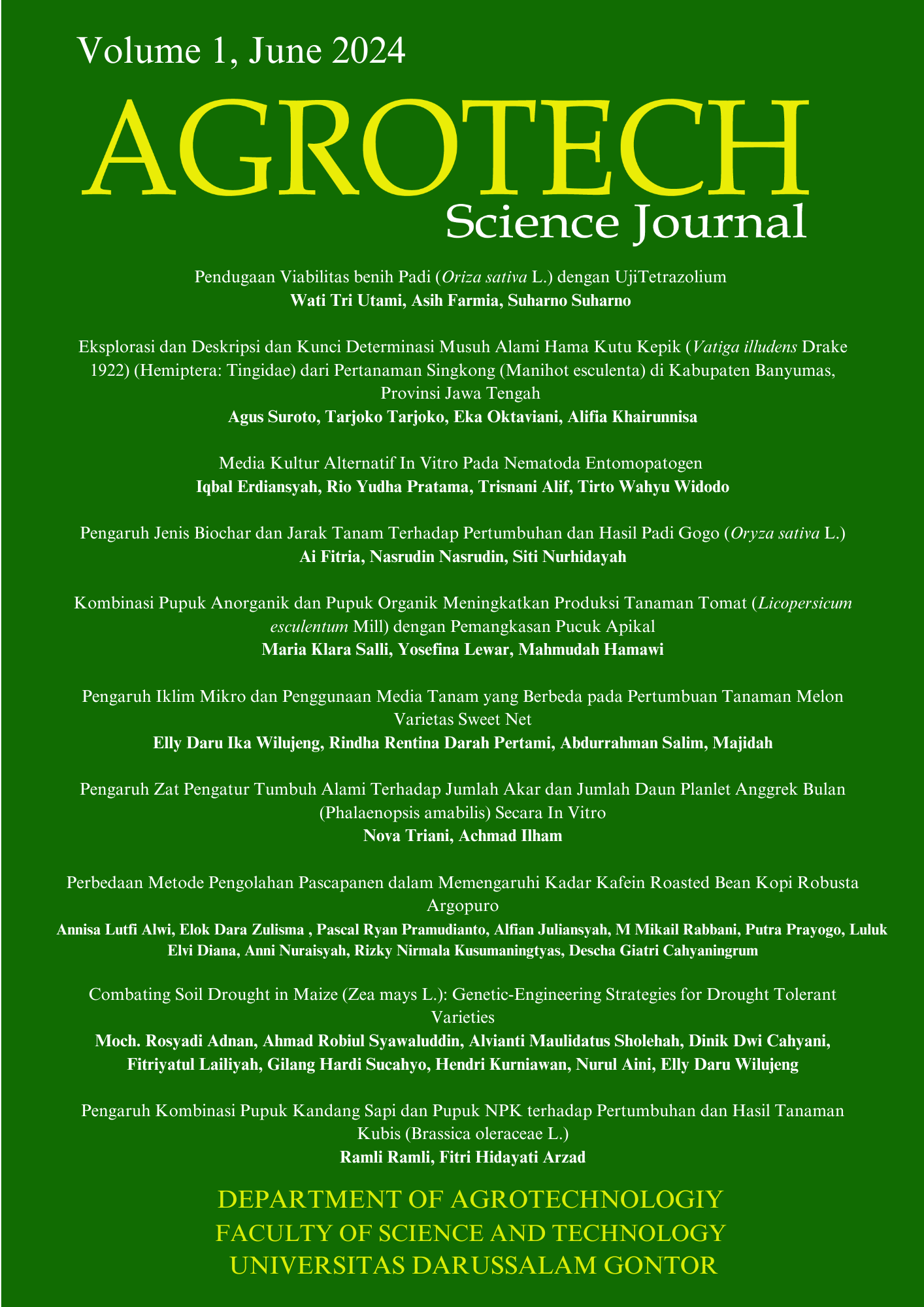Kombinasi Pupuk Anorganik dan Pupuk Organik Meningkatkan Produksi Tanaman Tomat (Licopersicum esculentum Mill) dengan Pemangkasan Pucuk Apikal
Combination of Inorganic and Organic Fertilizer on The Production of Tomato (Licopersicum esculentum Mill) with Appical Uper Pruning
DOI:
https://doi.org/10.21111/agrotech.v10i1.9277Keywords:
Pupuk Organik, pupuk an-organik, hasil, tomat betavilaAbstract
The research aims to determine the effect of a combination of inorganic fertilizer (KNO3) and organic fertilizer (goat manure) on the yield of the Betavila variety when apical shoots are pruned. The research took place from March to October 2019 in Kupang Regency, NTT. The research used RAK with 4 repetitions. The treatments are as follows: M1 = inorganic fertilizer 5 g/l KNO3; M2 = organic fertilizer 20 tons/ha goat manure; M3 = inorganic fertilizer 5 g/l KNO3 + organic fertilizer 30 tons/ha goat manure; M4 = inorganic fertilizer 5 g/l KNO3 + organic fertilizer 15 tons/ha goat manure; M5 = Inorganic fertilizer 3.75 g/l KNO3 + organic fertilizer 15 tons/ha goat manure; M6 = Inorganic fertilizer 3.75 g/l KNO3 + organic fertilizer 30 tons/ha goat manure; M7 = inorganic fertilizer 2.5 g/l KNO3 + organic fertilizer 15 tons/ha goat manure; M8 = inorganic fertilizer 2.5 g/l KNO3 + organic fertilizer 30 tons/ha goat manure. The results of the research showed that the combination of applying inorganic fertilizer and organic fertilizer simultaneously influenced the yield of Betavila variety tomato plants whose apical shoots had been pruned, namely on the number of fruits, fruit weight, and fruit production. Fertilization dose of inorganic fertilizer 3.75 g/l KN03 + organic fertilizer 30 tons/ha goat manure gave the number of fruits per plant (59.63 fruit), fruit production per plant (2.63 kg), and fruit production per experimental plot (50.33 kg) highest.References
Alfandi, A., Wahyuni, S., & Ipa, A. (2014). Pengaruh Takaran Pupuk Nitrogen dan Pupuk Kalium Terhadap Pertumbuhan dan Hasil Tanaman Tomat (Lycopercium esculentum Mill) Kultivar Permata. Jurnal Agroswagati, 2(September), 189–198. https://jurnal.ugj.ac.id/index.php/Agroswagati/article/view/1822
Izhar, L., Susila, A., Purwoko, B., Sutandi, &
Mangku, R. (2013). Penentuan Metode Terbaik Uji Kalium untuk Tanaman Tomat Pada Tanah Inceptisols (Determination of the Best Method of Soil K Test for Tomato On Inceptisols Soil Type). Jurnal Hortikultura, 23(3), 218–224. https://media.neliti.com/media/publications/98775-none-916eef35.pdf
Kaya, E. (2014). Pengaruh Pupuk Organik Dan Pupuk Npk Terhadap Ph Dan K-Tersedia Tanah Serta Serapan-K, Pertumbuhan, Dan Hasil Padi Sawah (Oryza sativa L). Buana Sains, 14(2), 113–122. https://jurnal.unitri.ac.id/index.php/buanasains/article/view/353/362
Keller, M., Scheele-Baldinger, R., Ferguson, J. C., Tarara, J. M., & Mills, L. J. (2022). Inflorescence temperature influences fruit set, phenology, and sink strength of Cabernet Sauvignon grape berries. Frontiers in Plant Science, 13(August), 1–13. https://doi.org/10.3389/fpls.2022.864892
Luthfyrakhman, H., & Susila, A. D. (2013). Optimasi Dosis Pupuk Anorganik dan Pupuk Kandang Ayam pada Budidaya Tomat Hibrida (Lycopersicon esculentum Mill. L.). Buletin Agrohorti, 1(1), 119. https://doi.org/10.29244/agrob.1.1.119-126
Salli, M. K., Ismael, Y. I., & Lewar, Y. (2016). Kajian Pemangkasan Tunas Apikal Dan Pemupukan KNO3 Terhadap Hasil Tanaman Tomat. Partner, 21(1). https://doi.org/10.35726/jp.v21i1.198
Salli, M. K., & Lehar, L. (2017). Respons Pertumbuhan Beberapa Varietas Tomat (Lycopersicum esculentum Mill) Yang Diaplikasikan Plant Growth Promoting Rhizobacteria (PGPR) di Lahan Kering. Partner, 22(1), 431. https://doi.org/10.35726/jp.v22i1.237
Salli, M. K., & Lewar, Y. (2019). Pengaruh Dosis Pupuk Kno3 dan Pupuk Kandang Terhadap Pertumbuhan Tanaman Tomat (Lycopersicum esculentum Mill.) Varietas Betavila yang Dipangkas Pucuk Apikalnya. Partner, 24(2), 955. https://doi.org/10.35726/jp.v24i2.354
Sinuraya, B. A., & Melati, M. (2019). Pengujian Berbagai Dosis Pupuk Kandang Kambing untuk Pertumbuhan dan Produksi Jagung Manis Organik (Zea mays var. Saccharata Sturt). Buletin Agrohorti, 7(1), 47–52. https://doi.org/10.29244/agrob.v7i1.24407
Subandi. (2013). Role and Management of Potassium Nutrient for Food Production in Indonesia. Agricultural Innovation Development, 6(1), 1–10. https://media.neliti.com/media/publications/30881-ID-role-and-management-of-potassium-nutrient-for-food-production-in-indonesia.pdf
Trivana, L., & Pradhana, A. Y. (2017). Optimalisasi Waktu Pengomposan dan Kualitas Pupuk Kandang dari Kotoran Kambing dan Debu Sabut Kelapa dengan Bioaktivator PROMI dan Orgadec. Jurnal Sain Veteriner, 35(1), 136. https://doi.org/10.22146/jsv.29301
Triyono, A., Purwanto, & Budiyono. (2013). Efisiensi Penggunaan Pupuk – N untuk Pengurangan Kehilangan Nitrat pada Lahan Pertanian. Prosiding Seminar Nasional Pengelolaan Sumber Daya Alam Dan Lingkungan, 1, 526–531. https://core.ac.uk/download/pdf/18605678.pdf
Downloads
Submitted
Accepted
Published
How to Cite
Issue
Section
License
The author whose published manuscript approved the following provisions:
1. The right of publication of all material published in the journal / published in the Gontor AGROTECH Science Journal is held by the editorial board with the knowledge of the author (moral rights remain the author of the script).
2. The formal legal provisions for access to digital articles of this electronic journal are subject to the terms of the Attribution 4.0 International, which means that Gontor AGROTECH Science Journal reserves the right to save, transmit media or format, Database), maintain, and publish articles without requesting permission from the Author as long as it keeps the Author's name as the owner of Copyright.
3. Printed and electronic published manuscripts are open access for educational, research and library purposes. In addition to these objectives, the editorial board shall not be liable for violations of copyright law.



